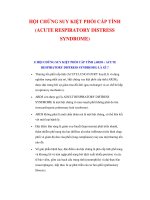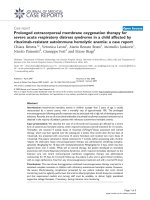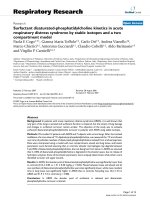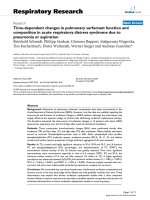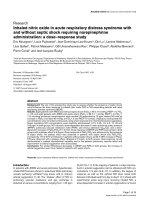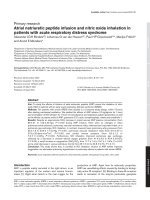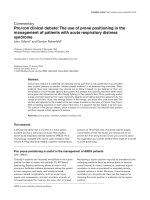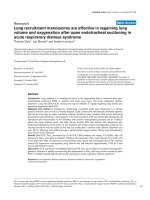- Trang chủ >>
- Y - Dược >>
- Truyền nhiễm
Extracorporeal membrane oxygenation in covid 19 related acute respiratory distress syndrome a euro elso international survey
Bạn đang xem bản rút gọn của tài liệu. Xem và tải ngay bản đầy đủ của tài liệu tại đây (1.12 MB, 34 trang )
Extracorporeal Membrane Oxygenation in COVID-19-related Acute
2
Respiratory Distress Syndrome – a EuroELSO international survey
3
4
Sebastian Mang1,2, Armin Kalenka3, Lars Mikael Broman4, Alexander Supady5,
5
Justyna Swol6, Guy Danziger1,2, André Becker1,2, Sabrina I. Hörsch1,7, Thilo
6
Mertke1,7, Ralf Kaiser1,2, Hendrik Bracht8, Viviane Zotzmann5, Frederik Seiler1,2,
7
Robert Bals1,2, Fabio Silvio Taccone9, Onnen Moerer10, Roberto Lorusso11, Jan
8
Bělohlávek12, Ralf M. Muellenbach13, and Philipp M. Lepper1,2 for the COVEC-Study
9
Group*
pe
er
re
v
iew
ed
1
10
Interdisciplinary COVID-19-Center, University Medical Centre, Saarland University,
Homburg/Saar, Germany
2 Department of Internal Medicine V - Pneumology, Allergology and Critical Care Medicine,
University Medical Centre, Saarland University, Homburg/Saar, Germany
3 Department of Anaesthesiology and Intensive Care Medicine, District Hospital Bergstrasse,
University Hospital Heidelberg, Heppenheim, Germany
4 ECMO Centre Karolinska, Department of Pediatric Perioperative Medicine and Intensive
Care, Karolinska University Hospital, Stockholm, Sweden
5 Department of Medicine III (Interdisciplinary Medical Intensive Care), Medical Center –
University of Freiburg, Faculty of Medicine, University of Freiburg, Germany
6 Department of Pneumology, Allergology and Sleep Medicine, and Intensive Care Medicine,
Paracelsus Medical University, General Hospital Nuremberg, Nuremberg, Germany
7 Department of Anaesthesiology, Critical Care Medicine and Pain Medicine, University
Medical Centre, Saarland University, Homburg/Saar, Germany
8 Department. of Anaesthesiology and Critical Care Medicine, University Hospital of Ulm,
Ulm, Germany
9 Department of Intensive Care, Erasme University Hospital, Université Libre de Bruxelles,
Brussels, Belgium
10 Department of Anaesthesiology, University Hospital of Göttingen, Göttingen, Germany
11Cardio-Thoracic Surgery Department - Heart & Vascular Centre - Maastricht University
Medical Centre, Maastricht, Netherlands
12 2nd Department of Internal Cardiovascular Medicine, General University Hospital, Prague,
Czech Republic
13 Department of Anaesthesiology and Critical Care Medicine, Campus Kassel of the
University of Southampton, Kassel, Germany
rin
tn
ot
1
ep
* Members of the study group are listed in the appendix
Word count: 2,544
Keywords:
COVID-19, SARS-CoV-2, ECMO, survey, CARDS
Pr
11
12
13
14
15
16
17
18
19
20
21
22
23
24
25
26
27
28
29
30
31
32
33
34
35
36
37
38
39
40
41
42
43
44
45
46
47
48
Running title:
ECMO for COVID-19 induced ARDS – EURO-ELSO-Survey
This preprint research paper has not been peer reviewed. Electronic copy available at: />
ECMO for COVID-19 induced ARDS – EURO-ELSO Survey
Correspondence to:
50
51
52
53
54
55
56
57
58
59
Philipp M. Lepper, MD
Department of Internal Medicine V – Pneumology, Allergology and Intensive Care
Medicine and ECLS Center Saar
University Hospital of Saarland
Kirrberger Str. 100
66421 Homburg
Germany
Phone:
+49-6841 16 15000
Fax:
+49-6841 16 15208
Email:
Pr
ep
rin
tn
ot
pe
er
re
v
iew
ed
49
2
This preprint research paper has not been peer reviewed. Electronic copy available at: />
Mang et al.
Background: Extracorporeal membrane oxygenation (ECMO) is a means to
61
support patients with acute respiratory failure. Initially, recommendations to treat
62
severe cases of pandemic Coronavirus Disease 2019 (COVID-19) with ECMO have
63
been restrained. In the meantime, ECMO has been shown to produce similar
64
outcomes in patients with severe COVID-19 compared to existing data on ARDS
65
mortality.
iew
ed
60
Objective: We performed an international email survey to assess how ECMO
67
providers worldwide have previously used ECMO during the treatment of critically ill
68
patients with COVID-19.
pe
er
re
v
66
69
Methods: A questionnaire with 45 questions (covering e.g. indication,
70
technical aspects, benefit and reasons for treatment discontinuation), mostly
71
multiple-choice, was distributed by email to ECMO centers. The survey was
72
approved by the European branch of the Extracorporeal Life Support Organization
73
(ELSO).
Results: 276 centers worldwide responded that they employed ECMO for
75
very severe COVID-19 cases, mostly in veno-venous configuration (87%). The most
76
common reason to establish ECMO was isolated hypoxemic respiratory failure
77
(50%), followed by a combination of hypoxemia and hypercapnia (39%). Only a
78
small fraction of patients required veno-arterial cannulation due to heart failure (3%).
79
Time on ECMO varied between less than two and more than four weeks. The main
80
reason to discontinue ECMO treatment prior to patient’s recovery was lack of clinical
81
improvement (53%), followed by major bleeding, mostly intracranially (13%). Only
82
4% of respondents reported that triage situations, lack of staff or lack of oxygenators
83
were responsible for discontinuation of ECMO support. Most ECMO physicians (66%
84
26%) agreed that patients with COVID-19 induced ARDS (CARDS) benefitted from
85
ECMO. Overall mortality of COVID-19 patients on ECMO was estimated to be about
86
55%, scoring higher than what has previously been reported for Influenza patients on
87
ECMO (29 – 36%).
89
tn
rin
Conclusion: ECMO has been utilized successfully during the COVID-19
pandemic to stabilize CARDS patients in hypoxemic or hypercapnic lung failure. Age
and multimorbidity limited the use of ECMO. Triage situations were rarely a concern.
Pr
90
ep
88
ot
74
91
ECMO providers stated that patients with severe COVID-19 benefitted from ECMO.
3
This preprint research paper has not been peer reviewed. Electronic copy available at: />
ECMO for COVID-19 induced ARDS – EURO-ELSO Survey
An increasing use in patients with respiratory failure in a future stage of the
93
pandemic may be expected.
Pr
ep
rin
tn
ot
pe
er
re
v
iew
ed
92
4
This preprint research paper has not been peer reviewed. Electronic copy available at: />
Mang et al.
94
Introduction
iew
ed
95
96
Early in 2020, countries worldwide have been facing a surge of patients with
97
acute respiratory distress syndrome (ARDS) due to pandemic Severe Acute
98
Respiratory Syndrome Coronavirus-2 (SARS-CoV-2) disease 2019 (COVID-19).
99
Survival of those most severely affected by COVID-19-related ARDS (CARDS) might
100
depend on extracorporeal membrane oxygenation (ECMO) as bridge to recovery1.
In this global pandemic, hospitals and healthcare systems have been pushed
102
to the verge of collapse. During the first phase of the COVID-19 pandemic, the
103
number of critically ill patients requiring invasive ventilation often exceeded ventilator
104
capacities, creating a need for ICU triage2. In this scenario, it was highly unlikely that
105
ECMO would be broadly recommended to critical care providers to treat COVID-19,
106
given its high demands on personnel and resources3. In its initial guidance
107
document, ELSO considered to offer ECMO only to specific patients not responding
108
to maximal conventional therapy, including proning and neuromuscular blockade4.
109
Additionally, early reports suggested mortality rates could be higher than 90% in
110
COVID-19 patients supported with ECMO5.
pe
er
re
v
101
A recent trial reported that ECMO reduced 60-day mortality in non-COVID-19
112
related ARDS to 35% in the ECMO group versus 46% in the conventional
113
management group (relative risk 0.76, 95% CI 0.55–1.04; p=0.09)6. The study
114
highlighted that ECMO can facilitate protective ventilation of ARDS patients with
115
reduced tidal volumes, plateau and driving pressures, mostly due to effective
116
extracorporeal CO2 removal. CARDS might not differ as much from non-COVID
117
ARDS as was previously expected7. Physiological considerations make it thus
118
reasonable to think about ECMO as a bail-out strategy in critically ill patients with
119
CARDS. A recently published retrospective data suggested that mortality of patients
120
with CARDS receiving ECMO might be comparable to past ARDS cohorts8. Given
121
that COVID-19 pathophysiology is still poorly understood, little is currently known
123
tn
rin
about how to tailor ECMO treatment to meet COVID-19 specific challenges, e.g.
hypercoagulable state9, or how long ECMO should be continued when patients fail to
improve.
Pr
124
ep
122
ot
111
125
We therefore designed an online survey to elicit how ECMO providers
126
worldwide have previously employed ECMO to treat critically ill COVID-19 patients.
5
This preprint research paper has not been peer reviewed. Electronic copy available at: />
ECMO for COVID-19 induced ARDS – EURO-ELSO Survey
Our survey was approved by the European branch of the Extracorporeal Life Support
128
Organization (EuroELSO).
Pr
ep
rin
tn
ot
pe
er
re
v
iew
ed
127
6
This preprint research paper has not been peer reviewed. Electronic copy available at: />
Mang et al.
129
Methods
iew
ed
130
131
We created a questionnaire consisting of 45 questions and distributed it to
132
4,193 physicians that had published on an ECMO-related topic since the year 2000
133
in a PubMed-listed journal with an available E-Mail using a commercially available
134
internet survey platform (SurveyMonkey Inc., San Mateo, California).
135
136
The ethical committee (Ärztekammer des Saarlandes) waived the need for a
formal approval since the questionnaire did not retrieve actual patient data.
138
pe
er
re
v
137
Questionnaire
139
The questionnaire was composed of two sections: the first dealt with general
141
questions regarding contact information, details on hospital and ICU capacity as well
142
as years of ECMO experience. The second part was designed to elicit most common
143
indications for ECMO use in COVID-19, details about ECMO circuit configuration as
144
well as complications and reasons for possible treatment discontinuation. We did not
145
ask for any patient-specific data. For conformity reasons and to facilitate participation
146
in the survey, most of the questions were multiple choice with two to nine possible
147
answers per question. The last eight items requested the participant to express his
148
extent of agreement with a specific statement about ECMO therapy in the context of
149
COVID-19 on a visual analogue scale. The survey is partly available in the
150
Supplementary Material.
151
The survey questions and multiple-choice responses with their respective
152
organization in the different sections were circulated and consented between a group
153
of 23 very experienced physicians in this field. When consensus of all questions and
154
answers was reached, the survey was transferred to an online platform
155
(SurveyMonkey Inc., San Mateo, California). Automatic data retrieval and descriptive
156
statistics were retrieved through this platform. More than one answer from centers
158
tn
rin
were possible. This was allowed, as many centers comprise several departments
with physicians from different backgrounds (e.g. anesthesiology and surgery).
Results from multiple-choice questions are expressed in median, participants’
Pr
159
ep
157
ot
140
160
extent of agreement or disagreement in mean and standard deviation in percent. The
161
survey was launched on 8th, deadline for return was 20th of June, 2020. Final
7
This preprint research paper has not been peer reviewed. Electronic copy available at: />
ECMO for COVID-19 induced ARDS – EURO-ELSO Survey
analysis of results was performed using an extrapolation tool provided by
163
SurveyMonkey as well as SPSS.
iew
ed
162
164
Participants were given the opportunity to be listed as collaborators. Those
165
participants who did not supply hospital or contact information or who did not
166
complete the survey could not be included in the list of collaborators.
167
168
Results
169
General data on ECMO centers and treatment capacities
pe
er
re
v
170
276 ECMO professionals from 98 centers in 30 different countries on four
172
continents (North America, South America, Europe, Asia) responded to the survey,
173
yielding a response rate of 6.6%. Sixty-four percent of responding centers were
174
ELSO members. As it was possible to skip questions, sometimes the denominator is
175
less than 276. In this case, the number of respondents is given in brackets.
176
Centers’ median number of years with ECMO experience was 14, mainly in ECMO
177
treatment of adults or adult and pediatric patients (85%). Only 1.3% of participants
178
were exclusively specialized in neonatal ECMO. Most common numbers of patients
179
supported with ECMO per year prior to COVID-19 in the participants’ centers ranged
180
from 21 to 50, 13% of centers having even supported more the 100 patients on
181
veno-venous ECMO (VV-ECMO) per year prior to the pandemic.
ot
171
182
Numbers of patients with COVID-19 with or without ECMO
tn
183
The majority of ECMO providers (30%) stated that 2 to 6 patients with COVID-
185
19 had received ECMO in their center, 85% of all centers having supported a
186
maximum of 15 patients on ECMO by survey deadline. ECMO treatment had mostly
187
been initiated in the participants’ hospitals (63%), only a minority of patients was
188
retrieved on ECMO by mobile ECMO retrieval teams from other hospitals.
190
191
Indication for ECMO and circuit configuration
The most common reason to initiate ECMO for COVID-19 was isolated
hypoxemia (50%), followed by a combination of hypoxemia and hypercapnia (39%).
Pr
192
ep
189
rin
184
193
Isolated hypercapnia was rarely a reason to cannulate a patient (3%). Only 6%
194
stated that ECMO was started to facilitate lung-protective ventilation (n = 105). The
195
majority of ECMO cannulations (88%) were performed in veno-venous configuration.
8
This preprint research paper has not been peer reviewed. Electronic copy available at: />
Mang et al.
Eight percent of centers used veno-arterial configuration (VA-ECMO) in one or more
197
patients and 3% had to extend to a V-AV-circuit in at least one case (one venous
198
draining cannula, one arterial returning cannula, one venous returning cannula). In
199
those cases, where an arterial cannulation was required, the indications were
200
specified as biventricular failure (n = 2) and, in one case, right heart failure due to
201
pulmonary embolism (n = 1). See also Figure 1, panel A and B.
iew
ed
196
202
203
Anticoagulation management
Targeting anticoagulation therapy in patients with COVID-19 on ECMO, 60%
205
of participants (n = 110) stated that they did not change their standard
206
anticoagulation strategy compared to cases of ARDS due to other causes. Forty
207
percent used higher doses of anticoagulants than usual, monitored by higher
208
prothrombin time or higher activated clotting time. Only one of 110 ECMO providers
209
stated that they deliberately used lower doses of anticoagulants than usual for
210
ECMO in COVID-19. Antiplatelet therapy was also rarely used (1%) to prevent
211
clotting. The details of the anticoagulants or antiplatelet agents administered were
212
not part of the survey. See also Figure 1 C.
213
214
Reasons to abstain from ECMO
pe
er
re
v
204
The two main reasons to refrain from ECMO initiation were patient age (74%)
216
and comorbidities (85%, not further specified). 28% of participants stated that ECMO
217
was withdrawn due to a patient’s known or suspected wishes. Nine percent decided
218
against ECMO because it was not actively recommended for COVID-19 induced
219
ARDS by responsible scientific societies at that time. Seven percent reported that a
220
surge of COVID-19 patients and overwhelming workload made ECMO impracticable.
221
Only 5% of participants reported that they had to abstain from ECMO initiation due to
222
a shortage of oxygenators, machines or ECMO cannulas.
Pr
ep
rin
tn
ot
215
9
This preprint research paper has not been peer reviewed. Electronic copy available at: />
ECMO for COVID-19 induced ARDS – EURO-ELSO Survey
223
Duration of ECMO support
Most patients were supported with ECMO for less than two weeks. However,
225
50% of all participants stated that they had also treated patients with ECMO for more
226
than four weeks (Figure 1 D).
iew
ed
224
227
228
Reasons for ECMO discontinuation
Seventy-two percent of participants confirmed that their center would
230
withdraw ECMO if there was no perspective for a COVID-19 patient to recover. If
231
ECMO treatment was discontinued prior to recovery, futility was mostly stated as the
232
reason (n = 50 from 94 responses, 53%). ECMO-related complications were the
233
second most important reason for treatment discontinuation. Fourteen percent of
234
ECMO providers stated that they had terminated ECMO due to major bleeding (n =
235
15), mainly intracranial hemorrhage (n = 13) and, less frequently, extracranially. In
236
1% of cases, not further specified technical issues led to ECMO withdrawal. The
237
question also offered ‘lack of staff’ as a possible answer, which was not chosen.
238
However, 2% of participants (n = 2, Germany and France) stated that a triage
239
situation forced physicians to discontinue ECMO prior to the patient’s possible
240
recovery. Two percent of respondents named lack of ECMO oxygenators, ECMO
241
machines or consumables as the reason for ECMO discontinuation. See also Figure
242
1 E.
ot
pe
er
re
v
229
243
Estimation of patients’ outcome
tn
244
When asked to estimate the percentage of patients who died while on ECMO
246
due to COVID-19, average mortality was estimated to be 55%, meaning that 45% of
247
patients had survived on ECMO at least until the end of the survey.
249
250
251
252
The last eight questions were designed to investigate a participant’s opinion
on certain statements about ECMO and COVID-19, measured in percentage of
agreement. Participants agreed to 63% 24% on average that patients were longer
on ECMO due to COVID-19 compared to other causes of ARDS. The claim that
Pr
253
ECMO providers’ opinions on COVID-19 and ECMO
ep
248
rin
245
254
CARDS patients on ECMO required more sweep gas flow than what the individual
255
ECMO physician was used to was accepted by 58% 25%. The statement that
10
This preprint research paper has not been peer reviewed. Electronic copy available at: />
Mang et al.
oxygenator change was more frequently required in CARDS patients on ECMO had
257
an acceptance rate of 54% on average 29%. The claim that disturbed coagulation
258
in COVID-19 patients would make ECMO impossible was mostly rejected (24%
259
agreement 26%). The assumption that ECMO offers patients with COVID-19
260
induced ARDS a chance to recover found relatively strong acceptance (agreement
261
extent of 76% 25%), with 66% 26% agreement with the claim that CARDS
262
patients benefitted from ECMO therapy. Box plots are displayed in Figure 2.
263
pe
er
re
v
For results not outlined here, see Supplementary Material.
Pr
ep
rin
tn
ot
264
iew
ed
256
11
This preprint research paper has not been peer reviewed. Electronic copy available at: />
ECMO for COVID-19 induced ARDS – EURO-ELSO Survey
Discussion
265
iew
ed
266
Survey results prove that critical care providers worldwide have repeatedly
268
successfully used extracorporeal membrane oxygenation to support patients in
269
COVID-19 related respiratory failure despite official recommendations were limited to
270
carefully singled-out patients. At the time the survey was launched, data regarding
271
the outcome of COVID-19 patients treated with ECMO was limited to case reports
272
and small case series. Recent retrospective cohort studies on COVID-19 patients
273
receiving ECMO have produced encouraging results8 but were unpublished at that
274
time. Critical care providers hence had to rely on what was already known about
275
ARDS from different causes. Both clinical experience and pathophysiology of
276
CARDS made ECMO appealing to treat COVID-19, even when data on mortality or
277
complication rate was missing.
pe
er
re
v
267
Several groups have reported evidence that COVID-19 might be associated
279
with a hypercoagulable state, resulting in an increased risk of thromboembolic
280
complications11. Exposing hypercoagulable blood to the artificial surface of an ECMO
281
circuit could therefore come with a considerable risk of thromboembolism.
282
Interestingly, when asked about ECMO-related complications in COVID-19, 13% of
283
ECMO providers stated that ECMO had to be terminated due to major bleeding, but
284
only one case of relevant pulmonary embolism on VV-ECMO was reported. It should
285
be noted though that minor thrombosis or thromboembolism could have remained
286
undetected during ECMO therapy, hence a reliable incidence of all thrombotic events
287
cannot be provided or was underestimated by the ECMO providers. Nevertheless,
288
given that 50% of all participants had treated patients on ECMO for more than four
289
weeks, the overall occurrence of lethal thromboembolism on ECMO in COVID-19
290
was surprisingly low. Only a minority of ECMO physicians said that they increased
291
the dosage of anticoagulants to prevent clotting on ECMO. There was also no
292
general agreement that oxygenator change was required more frequently compared
294
tn
rin
to patients with ARDS from other causes. Although increased rate of oxygenator
pump
head
thrombosis
in
COVID-19
has
been
reported12,
suspected
hypercoagulation in COVID-19 did not seem to translate to a higher incidence of life-
Pr
295
ep
293
ot
278
296
threatening pulmonary or systemic thromboembolism in patients with COVID-19 on
297
ECMO. Prospective studies should address how much anticoagulation for ECMO in
12
This preprint research paper has not been peer reviewed. Electronic copy available at: />
Mang et al.
COVID-19 is needed so that both the risk of thrombosis and hemorrhage can be
299
minimized.
iew
ed
298
Although predominantly affecting the lungs, multiple organ involvement of
301
COVID-19 has been reported. Cardiac complications in COVID-19 have recently
302
gathered broad attention. Acute myocardial injury in the absence of macroscopic
303
coronary artery disease is suspected to occur in up to 10% of patients especially in
304
the critically ill13,14,15,16. While 11% of our participants reported that they employed
305
also veno-arterial ECMO for COVID-19, only 3% of participants specified that arterial
306
cannulation was required because of acute heart or circulatory failure, in one case
307
caused by fulminant pulmonary embolism. So far, our survey results do not support
308
the hypothesis that severe cardiac involvement in COVID-19 translated to an
309
increased need for cardiac support (e.g. with VA-ECMO) in patients with CARDS.
pe
er
re
v
300
A recently published study investigating outcomes of all adult patients with
311
CARDS treated with ECMO using a EuroELSO registry estimated overall 90-day
312
mortality to be less than 40%8. When asked about the mortality of COVID-19
313
patients on ECMO, the mean estimation in our survey was 55%, meaning that
314
roughly 45% could be weaned off extracorporeal support at survey deadline. If this
315
data translates to real-life mortality, survival of COVID-19 patients on ECMO could
316
be comparable to non-COVID-19 induced ARDS. At the time of report, no
317
prospective data on the outcome nor complication rate of ECMO therapy in COVID-
318
19 is available. For the time being, our survey suggests that ECMO for COVID-19 is
319
practicable, effective and does not lead to higher complication rates in COVID-19 if it
320
is utilized in experienced ECMO centers. Most participants agreed that their patients
321
benefitted from ECMO therapy and stated that, in a hypothetical scenario of a future
322
respiratory pandemic, they would use it more readily to treat acute respiratory failure.
tn
rin
323
ot
310
Our survey has several limitations. Firstly, while it reflects opinions of a fairly
325
large cohort of physicians providing ECMO services, we nevertheless did not ask for
326
327
patient-specific data outcome. Hence, we cannot provide statistical evidence on
ECMO-related end points, e.g. overall survival, 28-day mortality or discharge from
ICU. Secondly, the survey was addressed mainly to tertiary care centers who have
Pr
328
ep
324
329
repeatedly published on ECMO, leading to a skewness of representation, possibly to
330
the disadvantage of primary and secondary care hospitals with less ECMO
331
experience.
13
This preprint research paper has not been peer reviewed. Electronic copy available at: />
ECMO for COVID-19 induced ARDS – EURO-ELSO Survey
332
Critical care providers need to know not only whether to use ECMO, but also
334
how to manage ECMO therapy in a disease as poorly understood as COVID-19.
335
Currently, this knowledge is expanding8. Across Europe, more than 2,100 patients in
336
180 centers were already treated on ECMO for respiratory and/or circulatory failure
337
due to COVID-19 ( last accessed
338
on November 23rd). The data from this survey (theoretical considerations early in the
339
pandemia) and the EuroELSO (real world data with weekly updates) data are in line,
340
suggesting that ECMO is a useful adjunctive tool in COVID-19-related respiratory
341
failure.
Pr
ep
rin
tn
ot
pe
er
re
v
iew
ed
333
14
This preprint research paper has not been peer reviewed. Electronic copy available at: />
Mang et al.
342
Declarations
344
iew
ed
343
Conflict of interest disclosure
345
Robert Bals declares funding from AstraZeneca, Boehringer Ingelheim,
347
GlaxoSmithKline, Grifols, Novartis, CLS Behring, the German Federal Ministry of
348
Education and Research (BMBF) Competence Network Asthma and COPD
349
(ASCONET), Sander-Stiftung, Schwiete-Stiftung, Krebshilfe and Mukoviszidose eV.
350
Conflicts that the editors consider relevant to the content of the manuscript have
351
been disclosed. All other authors: No potential conflicts of interest
352
353
Financial funding
354
355
356
COVID-19 research was funded by the Federal state of Saarland, Saarland
University and Dr. Rolf M. Schwiete Foundation.
357
358
pe
er
re
v
346
Acknowledgements
359
The authors are grateful to all colleagues worldwide for their generous
361
participation in our survey. We thank the EuroELSO steering committee for
362
supporting the survey.
364
tn
363
Consent to be listed as collaborator
365
368
369
370
371
were included as collaborators.
Authorship Contribution
S.M., A.K., A.B., G.D., S.H., T.M. and P.L. drafted the survey. L.M.B, J.S.,
H.B., F.S.T., O.M., R.L., J.B. and R.M. revised the survey for important content. P.L.
Pr
372
rin
367
All colleagues who participated in the survey and agreed to be named publicly
ep
366
ot
360
373
launched the survey and oversaw collection of data. R.K. provided IT-tools for survey
374
preparation. S.M. drafted manuscript. A.K., L.M.B., A.S., J.S., G.D., S.H., F.S., R.B.,
15
This preprint research paper has not been peer reviewed. Electronic copy available at: />
ECMO for COVID-19 induced ARDS – EURO-ELSO Survey
F.T., O.M., R.L, J.B., R.M. and P.L. revised the manuscript for important intellectual
376
content. All authors have seen and approved the final version of the manuscript.
Pr
ep
rin
tn
ot
pe
er
re
v
iew
ed
375
16
This preprint research paper has not been peer reviewed. Electronic copy available at: />
Mang et al.
*The COVID-19 ECMO (COVEC) study group
378
iew
ed
377
379
Nicholas Barrett, Guy’s and St Thomas’ NHS Foundation Trust, London, UK;
380
Daniel Duerschmied, University Hospital of Freiburg, Freiburg, Germany;
381
Eddy Fan, Toronto General Hospital, Toronto, Canada;
382
Falk Fichtner, Universitätsklinikum Leipzig, Leipzig, Germany;
383
Hendrik Haake, Krankenhaus Maria Hilf, Mönchengladbach, Germany;
384
Frank Langer, University Medical Centre, Saarland University, Homburg/Saar,
Germany;
pe
er
re
v
385
386
Haitham Mutlak, Sana Klinikum Offenbach, Offenbach, Germany;
387
Markus Kredel, University Hospital of Würzburg, Würzburg, Germany;
388
Thomas Müller, University Hospital of Regensburg, Regensburg, Germany;
389
Alessandro Protti, Humanitas Research and Clinical Centre-IRCCS, Milan, Italy
390
Alexander Raddatz, University Medical Centre, Saarland University, Homburg/Saar,
391
Germany
392
Tobias Spangenberg, Marienkrankenhaus Hamburg, Hamburg, Germany;
393
Dawid Staudacher, University Hospital of Freiburg, Freiburg, Germany;
394
Holger Wehrfritz, University Medical Centre, Saarland University, Homburg/Saar,
395
Germany
Tobias Wengenmayer, University Hospital of Freiburg, Freiburg, Germany;
397
Arne Westheider, University Medical Centre, Saarland University, Homburg/Saar,
Germany;
tn
398
ot
396
Pr
ep
rin
399
17
This preprint research paper has not been peer reviewed. Electronic copy available at: />
ECMO for COVID-19 induced ARDS – EURO-ELSO Survey
Survey Collaborators:
401
402
France
403
iew
ed
400
Simon Dang Van, University Hospital of Angers, France;
405
Cedric Daubin, Hospital Center University of Caen Normandie, France;
406
Philippe Gaudard, CHU Montpellier, University Montpellier, France;
407
Thomas Godet, University Hospital of Clermont-Ferrand, France;
408
Pierre-Grégoire Guinot, Département d’Anesthésie-Réanimation, Centre Hospitalier
409
pe
er
re
v
404
Universitaire de Dijon, France;
410
Lọc Le Guennec, Hơpital Universitaire Pitié Salpêtrière, Paris, France;
411
Bruno Megarbane, Lariboisière Hospital, University of Paris, France;
412
Alain Mercat, Centre Hospitalier Universitaire d'Angers, France;
413
Romain Sonneville, Bichat-Claude Bernard University Hospital, France;
414
Elie Zogheib, Medical Intensive care - CHU Amiens, France;
415
Tai Pham, Medecine Intensive-Réanimation, Hôpital Bicêtre, APHP, Le Kremlin
416
417
418
Bicêtre, France
Hadrien Winiszewski, Centre Hospitalier Rộgional Universitaire de Besanỗon,
France;
420
ot
419
Austria
tn
421
Peter Schellongowski, Dept. of Medicine I, Medical University of Vienna, Austria;
423
Thomas Staudinger, Dept. of Medicine I, Medical University of Vienna, Austria;
424
Dominik Wiedemann, Department of Cardiac Surgery, Medical University of Vienna,
425
rin
422
Austria;
Corinna Velik-Salchner, Medical University Innsbruck, Austria;
427
Michael Joannidis, Medical University Innsbruck, Dept. Internal Medicine, Division of
428
429
Intensive Care and Emergency Medicine, Austria;
Pr
430
ep
426
18
This preprint research paper has not been peer reviewed. Electronic copy available at: />
Mang et al.
Germany
432
iew
ed
431
433
Marc Bodenstein, University Medical Center Mainz, Germany;
434
Heinrich Volker Groesdonk, Dept. of Intensive Care Medicine and Intermediate Care;
Helios Clinic Erfurt, Germany;
435
Stefan Guth, Kerckhoff-Klinik, Bad Nauheim, Germany;
437
Matthias Hecker, University Hospital Giessen, Medical Clinic II, Germany;
438
Faeq Husain-Syed, University Hospital Giessen and Marburg, Giessen, Germany;
439
Christian Jung, Heinrich-Heine-University Düsseldorf, Germany;
440
L. Christian Napp, Hannover Medical School, Germany;
441
Ruslan Natanov, Hannover Medical School, Germany;
442
Georg Trummer, Universitaets-Herzzentrum Freiburg Bad Krotzingen, Germany;
443
Sascha Treskatsch, Charité – University Hospital Berlin, Department of
Anesthesiology and Intensive Care Medicine, Berlin, Germany;
444
445
pe
er
re
v
436
Henryk Welp, University Hospital Münster, Germany;
446
447
Italy
448
Leonello Avalli, Ospedale San Gerardo, Monza, Italy;
450
Lorenzo Ball, Università degli studi di Genova, Genova, Italy;
451
Mirko Belliato, Foundation IRCCS Policlinico San Matteo, Pavia, Italy;
452
Manuela Bonizzoli, Intensive Care Unit, Careggi Hospital, Florence, Italy;
453
Emma Borrelli, University of Siena, Siena, Italy;
454
Giacomo Cavallaro, Fondazione IRCCS Ca' Granda Ospedale Maggiore Policlinico,
tn
Milano, Italy;
rin
455
ot
449
Andrea Franci, Azienda Odpedaliero Universitaria Careggi, Florence, Italy;
457
Silvia Gramaticopolo, Ospedale San Bortolo Vicenza, Italy;
458
Mauro Panigada, Fondazione IRCCS Ca' Granda Ospedale Maggiore Policlinico
459
460
Milano, Italy;
Luigi Tritapepe, San Camillo-Forlanini Hospital, Rome, Italy;
Pr
461
ep
456
462
Saudi Arabia
463
464
Salman Abdulaziz, King Saud Medical City, Saudi Arabia;
19
This preprint research paper has not been peer reviewed. Electronic copy available at: />
ECMO for COVID-19 induced ARDS – EURO-ELSO Survey
Canada
466
iew
ed
465
467
David Bracco, McGill University Health Center, Montreal, Canada;
468
Yiorgos Alexandros, Cavayas Hôpital du Sacré-Coeur de Montréal, Montréal,
469
Canada;
Ari Joffe, Stollery Children's Hospital, Alberta, Canada;
471
A. Dave Nagpal, London Health Sciences Centre, London, Canada;
472
Ying Sia, University Institute of Cardiology and Respirology of Quebec, Quebec,
473
Canada;
474
475
United Kingdom
476
pe
er
re
v
470
477
Georg Auzinger, King's College Hospital London, United Kingdom;
478
Vasileios Zochios, University Hospitals of Leicester NHS Trust, Glenfield Hospital
479
ECMO Unit, Lecester, United Kingdom;
480
481
United States of America
482
Alejandro Garcia, Johns Hopkins University, Baltimore, Maryland, United States;
484
Katja Gist, University of Colorado, Boulder, Colorado, United States;
485
Dana Lustbader, ProHEALTH an OPTUM Company, New York, New York, United
States;
tn
486
ot
483
Demetris Yannopoulos, University of Minnesota, Minneapolis, Minnesota, United
488
States;
489
R. Scott Stephens, Johns Hopkins University, Baltimore, Maryland, United States;
490
Joseph Tonna, University of Utah, Salt Lake City, Utah, United States;
491
Linda Paxton, St. Mary's Hospital, Richmond, Virginia, United States;
492
Hitoshi Hirose, Thomas Jefferson University Hospital, Philadelphia, Pennsylvania,
494
United States;
Bo Kim, Johns Hopkins University, Baltimore, Maryland, United States;
Pr
495
ep
493
rin
487
496
Sweden
497
498
Magnus Dalén, Karolinska University Hospital and Karolinska Institutet, Sweden;
20
This preprint research paper has not been peer reviewed. Electronic copy available at: />
Mang et al.
499
Czech Republik
501
Martin Balik, Complex Cardiac Center, General University Hospital, Prague, Czech
Republic;
502
503
iew
ed
500
David Janak, Charles University of Prague, Department of Cardiovascular Surgery,
Prague, Czech Republic;
504
505
506
Chile
pe
er
re
v
507
508
Luis Castillo, Hospital Barros Luco, Santiago, Chile;
509
Alejandro Bruhn; Pontificia Universidad Catolica de Chile, Santiago, Chile;
510
511
Colombia
512
513
Jorge Luis Alvarado Socarras, Fundacion Cardiovascular de Colombia,
Bucaramanga, Santander, Colombia;
514
515
516
South Korea
517
Taeyun Kim, Seongnam Citizens Medical Center, Seongnam, South Korea;
519
Hyoung Soo Kim, Hallym University Sacred Heart Hospital, Seoul, South Korea;
520
Joung Hun Byun, Gyeongsang National University College of Medicine, Changwon,
tn
ot
518
South Korea;
521
523
524
Brazil
rin
522
Guilherme Mainardi, Hospital São Camilo, Brazil;
526
Pedro Mendes, Hospital das Clinicas de São Paulo HC-FMUSP, São Paulo, Brazil;
527
528
Switzerland
Pr
529
ep
525
530
Raphaël Giraud, Geneva University Hospitals, Geneva, Switzerland;
531
532
21
This preprint research paper has not been peer reviewed. Electronic copy available at: />
ECMO for COVID-19 induced ARDS – EURO-ELSO Survey
533
Portugal
iew
ed
534
535
Philip Fortuna, Centro Hospitalar Universitário de Lisboa Central, Lisbon, Portugal;
536
Japan
537
538
Tatsuma Fukuda, University of the Ryukyus, Nakagami District, Okinawa, Japan;
539
540
The Netherlands
542
pe
er
re
v
541
Jacinta Maas, Leiden University Medical Center, Leiden, The Netherlands;
543
544
Poland
545
546
Dariusz Maciejewski, Regional Teaching Hospital, Bielsko-Biała, Poland;
547
548
India
549
550
Deblal Pandit, Medica Superspecialty Hospital Kolkata, Calcutta, India;
551
Israel
ot
552
553
Yosv Psz, General Intensive Care Unit, Tel Aviv Sourasky Medical Center, Tel Aviv,
Israel;
555
556
Slovenia
rin
557
558
559
Peter Radsel, University Medical Center Ljubljana, Slovenia;
562
China
Gangfeng Yan, Children's Hospital of Fudan University, China;
Pr
563
ep
560
561
tn
554
22
This preprint research paper has not been peer reviewed. Electronic copy available at: />
Mang et al.
References
iew
ed
564
1. Savarimuthu, Sugeevan; BinSaeid, Jalal; Harky, Amer (2020) The role of
ECMO in COVID-19: Can it provide rescue therapy in those who are critically
ill? Journal of cardiac surgery. 35:6;1298–1301.
569
570
571
2. Phua, Jason; Weng, Li; Ling, Lowell, et al (2020) Intensive care management
of coronavirus disease 2019 (COVID-19): challenges and recommendations.
Lancet Respir Med. 2020 May; 8(5): 506–517
572
573
574
575
3. MacLaren, Graeme; Fisher, Dale; Brodie, Daniel et al (2020) Preparing for the
Most Critically Ill Patients With COVID-19: The Potential Role of
Extracorporeal Membrane Oxygenation. JAMA. DOI:
10.1001/jama.2020.2342.
576
577
578
4. Bartlett, Robert H.; Ogino, Mark T.; Brodie, Daniel (2020) Initial ELSO
Guidance Document: ECMO for COVID-19 Patients with Severe
Cardiopulmonary Failure. ASAIO Journal. 66(5):472-474
579
580
581
582
583
5. Henry, Brandon Michael; Lippi, Giuseppe (2020) Poor survival with
extracorporeal membrane oxygenation in acute respiratory distress syndrome
(ARDS) due to coronavirus disease 2019 (COVID-19): Pooled analysis of
early reports. Journal of critical care, 58:27–28. DOI:
10.1016/j.jcrc.2020.03.011.
584
585
586
587
6. Combes, Alain; Hajage, David; Capellier, Gilles et al. (2018) Extracorporeal
Membrane Oxygenation for Severe Acute Respiratory Distress Syndrome.
The New England journal of medicine, 378:21;1965–1975. DOI:
10.1056/NEJMoa1800385.
588
589
590
591
7. Ferrando, Carlos; Suarez-Sipmann, Fernando; Mellado-Artigas, et al. (2020)
Clinical features, ventilatory management, and outcome of ARDS caused by
COVID-19 are similar to other causes of ARDS. Intensive care medicine. DOI:
10.1007/s00134-020-06192-2
592
593
594
595
8. Barbaro, Ryan P.; MacLaren, Graeme; Boonstra, Philip S. et al. (2020)
Extracorporeal membrane oxygenation support in COVID-19: an international
cohort study of the Extracorporeal Life Support Organization registry. The
Lancet. DOI: 10.1016/S0140-6736(20)32008-0.
596
597
598
9. Iba, Toshiaki; Levy, Jerrold H.; Levi, Marcel; Connors, Jean Marie; Thachil,
Jecko (2020) Coagulopathy of Coronavirus Disease 2019. Critical care
medicine. DOI: 10.1097/CCM.0000000000004458.
ot
tn
rin
ep
10. Amato, Marcelo B P; O Meade, Maureen; Slutsky, Arthur S et al (2015)
Driving pressure and survival in the acute respiratory distress syndrome. The
New England Journal of Medicine, 19;372(8):747-55
Pr
599
600
601
pe
er
re
v
565
566
567
568
602
603
604
605
11. Ranucci, Marco; Ballotta, Andrea; Di Dedda, Umberto et al. (2020) The
procoagulant pattern of patients with COVID-19 acute respiratory distress
syndrome. Journal of thrombosis and haemostasis,18:7;1747–1751. DOI:
10.1111/jth.14854
23
This preprint research paper has not been peer reviewed. Electronic copy available at: />
ECMO for COVID-19 induced ARDS – EURO-ELSO Survey
12. Bemtgen, Xavier; Zotzmann, Viviane; Benk, Christoph; et al. (2020)
Thrombotic circuit complications during venovenous extracorporeal
membrane oxygenation in COVID-19. Journal of thrombosis and
thrombolysis. DOI: 10.1007/s11239-020-02217-1.
610
611
612
13. Wang, Dawei; Hu, Bo; Hu, Chang et al (2020) Clinical Characteristics of 138
Hospitalized Patients With 2019 Novel Coronavirus-Infected Pneumonia in
Wuhan, China. JAMA. DOI: 10.1001/jama.2020.1585
613
614
615
616
14. Chen, C.; Yan, J. T.; Zhou, N.; Zhao, J. P et al (2020) Analysis of myocardial
injury in patients with COVID-19 and association between concomitant
cardiovascular diseases and severity of COVID-19. Zhonghua xin xue guan
bing za zhi, 48:0, E008. DOI: 10.3760/cma.j.cn112148-20200225-00123.
617
618
619
620
15. Lippi, Giuseppe; Lavie, Carl J.; Sanchis-Gomar, Fabian (2020) Cardiac
troponin I in patients with coronavirus disease 2019 (COVID-19): Evidence
from a meta-analysis. Progress in cardiovascular diseases. DOI:
10.1016/j.pcad.2020.03.001.
621
622
623
624
16. Esposito, Antonio; Palmisano, Anna; Natale, Luigi; Ligabue, Guido; Peretto,
Giovanni; Lovato, Luigi et al. (2020) Cardiac Magnetic Resonance
Characterization of Myocarditis-Like Acute Cardiac Syndrome in COVID-19.
In : JACC. Cardiovascular imaging. DOI: 10.1016/j.jcmg.2020.06.003.
Pr
ep
rin
tn
ot
pe
er
re
v
iew
ed
606
607
608
609
24
This preprint research paper has not been peer reviewed. Electronic copy available at: />
Mang et al.
628
629
Sebastian Mang1,2, Armin Kalenka3, Lars Mikael Broman4, Alexander Supady5,
630
Justyna Swol6, Guy Danziger1,2, André Becker1,2, Sabrina I. Hörsch1,7, Thilo
631
Mertke1,7, Ralf Kaiser1,2, Hendrik Bracht8, Viviane Zotzmann5, Frederik Seiler1,2,
632
Robert Bals1,2, Fabio Silvio Taccone9, Onnen Moerer10, Roberto Lorusso11, Jan
633
Bělohlávek12, Ralf M. Muellenbach13, and Philipp M. Lepper1,2 for the COVEC-Study
634
Group*
pe
er
re
v
iew
ed
627
Extracorporeal Membrane Oxygenation in COVID-19-related Acute
Respiratory Distress Syndrome – a EuroELSO international survey
626
635
636
Supplementary Data
637
638
Results – Details on participating ECMO centers
639
Countries with most replies were Germany (32), the United States of America
641
(32), Italy (16), France (15) and Canada (11) (Supplementary Figure 1).
642
Participants were mostly ECMO providers at larger hospitals and tertiary care
643
centers, the majority having a capacity of over 1,000 beds in total, 60% having at
644
least 21 ICU beds on their ward. ICUs employing ECMO were mostly
645
interdisciplinary (66%) and, to a lesser extent, surgical (18%) or non-surgical (16%).
646
ECMO wards were mainly run by critical care physicians (59%), followed by Cardiac
647
surgeons (19%) and Anesthesiologists (9%). The vast majority of ECMO providers
648
(70%) stated that their center had previously increased ECMO capacity in the face of
649
COVID-19, in median by 25 – 50%. 19% managed to double their ECMO capacity
650
(Supplementary Table 1 and 2).
653
654
655
tn
Results – Numbers of critically-ill patients with or without ECMO
By survey deadline, most centers had treated a median of 21-40 patients with
COVID-19 (both intensive and normal care units), 73 of 149 had treated more than
100 patients. Those centers experiencing a high emergence of COVID-19 patients
Pr
656
rin
652
ep
651
ot
640
657
were mostly localized in countries which were most severely affected by the
658
pandemic at that time (France 18%, Italy 17%, USA 14% and Germany 11%). 41%
25
This preprint research paper has not been peer reviewed. Electronic copy available at: />
